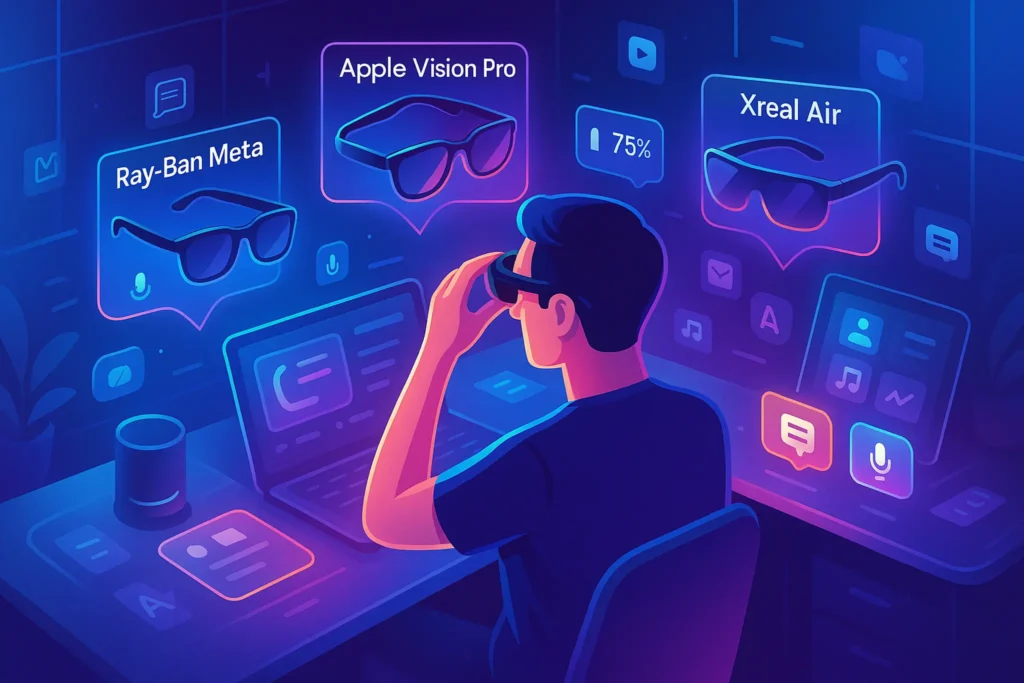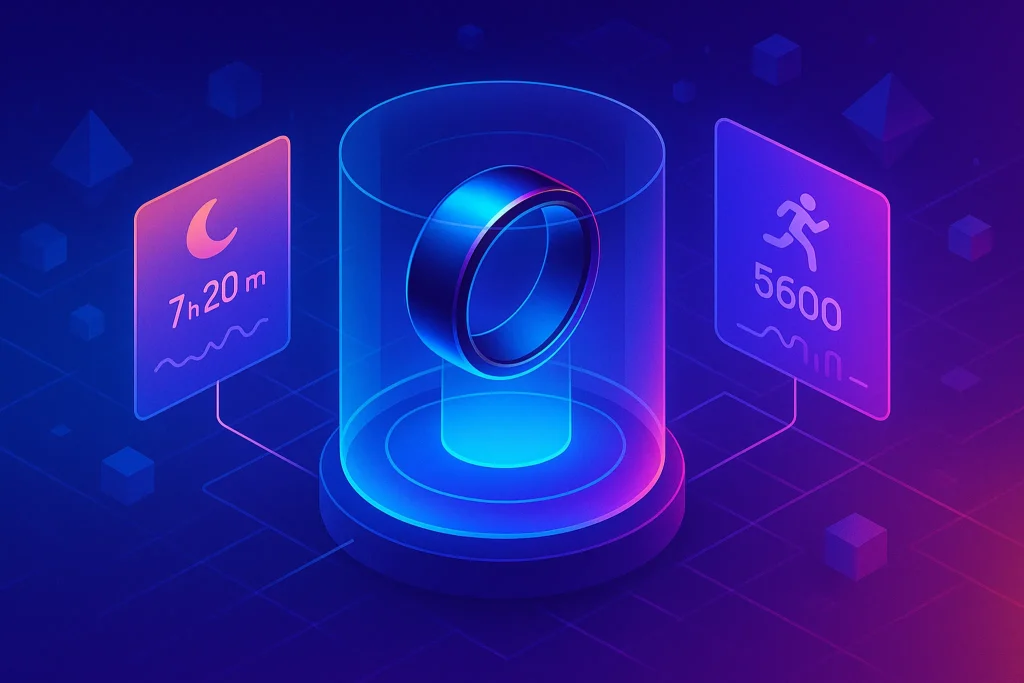🧠 Introduction
In the early 2010s, Google Glass sparked global fascination—and then faded just as fast. Over a decade later, smart glasses are back, sleeker, smarter, and more connected than ever. From Ray-Ban Meta’s camera-powered social wearables to Xreal’s immersive AR displays and Apple’s vision-centric ecosystem, the industry is once again betting big on eyewear as the next interface.
But here’s the big question: Are smart glasses finally ready for the mainstream? Or are we staring into a hyped-up future that’s still years away?
This post dives into where we stand in 2025, what these gadgets can actually do, what’s holding them back, and whether they’re destined to become the next smartphone—or just another niche tech toy.
🔍 Where Smart Glasses Stand in 2025
Smart glasses are no longer futuristic prototypes—they’re available, shippable, and (for early adopters) wearable. But the industry still faces a crucial gap between expectation and experience.
Most modern models fall into two categories:
-
Notification-focused wearables: Like Ray-Ban Meta Smart Glasses, which pair with your phone and let you take hands-free photos, video, or even livestream.
-
AR projection headsets: Like Xreal Air 2 Ultra or Apple Vision Pro Glass, aiming to bring spatial interfaces, immersive screens, and full digital overlays to everyday life.
These devices offer glimpses of the future—but are they compelling enough in their current form?
For a broader view on where wearables are heading, you may want to explore our post on Wearable Tech in 2025, where we dive deeper into trends across smartwatches, rings, and more.
🔧 What These Glasses Can (and Can’t) Do
Let’s demystify the reality.
✅ What They Can Do:
-
Stream video or display screens in your field of vision (Xreal)
-
Let you capture POV footage with voice control (Meta)
-
Display notifications or translate languages in real-time (startup glasses like Viture One or TCL NXTWEAR)
-
Integrate with voice assistants for music, calls, or queries
❌ What They Can’t Do Well (Yet):
-
Deliver all-day battery life
-
Replace your phone for productivity
-
Support diverse third-party apps
-
Provide seamless indoor-outdoor AR switching
-
Feel invisible or fashionable enough for mass adoption
While Ray-Ban Meta focuses more on camera-as-interface for creators and social moments, Apple’s Vision Glass pushes toward spatial computing—but with a cost and complexity barrier that’s hard to ignore.
“We’re not selling a product—we’re selling a new way of seeing the world.”
— Meta spokesperson, launch of Ray-Ban Smart Glasses Gen 2
🧱 Why Market Adoption Has Been Slower Than Expected
Despite the futuristic appeal, smart glasses still face major barriers to mainstream adoption. Here’s why the average consumer isn’t racing to buy them:
1. User Experience Still Feels “Beta”
Most models require phone tethering, awkward gestures, or inconsistent UI. Unlike smartphones, they don’t offer a plug-and-play ecosystem.
2. Battery Life Is a Bottleneck
With AR-enabled displays and camera modules, battery life often maxes out at 2–3 hours of active use—far from what’s needed for daily wear.
3. Privacy Concerns
People don’t love being recorded without knowing. Ray-Ban Meta’s subtle cameras have sparked public conversations around digital consent in social spaces.
4. Lack of Compelling Use Cases
Beyond content creation or productivity demos, there’s no “killer app” yet that justifies everyday use for the average person.
5. Style vs. Tech Trade-off
Many smart glasses look… well, nerdy. While Ray-Ban and Apple are pushing aesthetics, it’s still hard to balance form with function.
In short: the hardware is impressive, but the value proposition still feels incomplete—a topic we also examined in Top Futuristic Gadgets You Can Own Now, where smart glasses made the list with caveats.
📡 Stay Ahead of the Curve: AR, Wearables & Future Gadgets
Join 2,000+ future-focused readers getting weekly intel on smart glasses, AI wearables, spatial computing, and the next big gadget shifts—before they go mainstream.
🧠 Curated by NerdChips. No noise. Just the smartest tech trends and tools—delivered once a week.
🏷️ Key Players in 2025: A Quick Brand Breakdown
🔹 Ray-Ban Meta Smart Glasses (Gen 2)
-
Focus: Social content, photos, livestreaming
-
Strengths: Aesthetic design, Meta AI voice assistant, good mic/audio quality
-
Weaknesses: Limited AR, short battery, mostly for creators
🔹 Xreal Air 2 & Air 2 Ultra
-
Focus: Personal theater, portable AR display
-
Strengths: High-quality screen projection, lightweight, growing support for Android/Windows
-
Weaknesses: Needs tethering, limited interactivity, app support evolving
🔹 Apple Vision Glass / Pro Ecosystem
-
Focus: Spatial computing, productivity, immersive environments
-
Strengths: Unmatched display and interface polish, Apple ecosystem integration
-
Weaknesses: Expensive, bulky, more a headset than “glasses”
You can read more about Apple’s spatial approach in our in-depth Apple Vision Pro Review, where we unpacked the hardware, software, and user reactions.
⚖️ Comparison Table: Smart Glasses Showdown
| Feature | Ray-Ban Meta | Xreal Air 2 Ultra | Apple Vision Pro |
|---|---|---|---|
| AR Capabilities | ❌ Basic | ✅ Screen-only AR | ✅✅ Full spatial |
| Battery Life | ⚠️ ~2 hours | ⚠️ 2–3 hours tethered | ⚠️ ~2.5–3 hours |
| Design/Style | ✅ Fashionable | ⚠️ Tech-forward | ⚠️ Bulky headset |
| Content Creation | ✅ Strong video/photo | ❌ Display-only | ✅ Immersive tools |
| Price Range | 💵 $299–$349 | 💵 $379–$699 | 💸 $3499+ |
| Ecosystem Integration | ✅ Meta, Facebook | ⚠️ Android/Windows | ✅ Apple Native |
🔮 The Future: Mainstream Promise or Niche Plateau?
So where are smart glasses headed?
Analysts predict a 5-year runway before smart glasses become fully mainstream—and it hinges on three things:
-
Battery and Chip Efficiency
The moment these devices can run 8–10 hours without overheating or needing a smartphone, adoption will surge. -
Platform-Centric Use Cases
If companies like Apple or Meta build compelling exclusive experiences—like immersive FaceTime, spatial YouTube, or AI-guided AR search—users will have real reasons to wear them daily. -
Cultural Normalization
Just like AirPods once looked awkward, smart glasses need cultural validation. Expect this to come through creators, influencers, and workplace adoption.
🚀 Imagine checking your calendar, recording POV content, and navigating maps—all through your lenses, without touching your phone.
Still, the road is bumpy. Until those three breakthroughs occur, smart glasses may remain a luxury toy for tech-forward creators and not a mass-consumer staple.
For more insight on wearables with real-world impact, visit Top Wearable Gadgets to Stay Healthy, where we explore devices with actual daily utility.
🧪 A Day in the Life With Smart Glasses (Real Use Scenario)
To understand how smart glasses actually fit into daily life, let’s walk through a typical day for a creator or tech-forward remote worker in 2025:
☀️ Morning
You slip on your Ray-Ban Meta while heading out for a quick walk. Using voice command, you record a 15-second POV Reel—hands-free, no phone needed.
🕛 Midday
While waiting for your coffee order, you put on your Xreal Air 2 Ultra, connect it to your Android phone, and review your Slack messages and YouTube Studio analytics in a 201-inch virtual screen floating right in front of you.
🌆 Evening
At home, your Apple Vision Glass reminds you of a FaceTime meeting. You join the call spatially while prepping dinner—no phone in hand, no laptop in sight.
The result? Your day remains untethered, but still connected. And you’re blending content creation, communication, and entertainment—seamlessly through wearable tech.
For more visions of this future, see our feature on AR and VR in Everyday Life, where we map out how interfaces are moving off screens and into space.
🧭 Reality Check: Is This for You… or Not Yet?
Smart glasses are exciting—but are they right for you today?
Here’s a quick decision matrix to help:
Is It Time to Buy Smart Glasses?
Go for it if:
– You’re a content creator or like POV storytelling
– You’re excited about spatial interfaces or AR experimentation
– You want hands-free media capture or voice interaction
Maybe wait if:
– You expect productivity apps to be flawless and fast
– Battery life under 3 hours is a deal-breaker
– You’re hoping to fully replace your phone or laptop soon
Bottom Line: For explorers and early adopters? Yes. For mainstream use? Not quite yet.
🧾 Adoption Likelihood Scale
How likely are smart glasses to become mainstream by 2027?
We asked industry insiders, analysts, and early adopters. Here’s the current consensus:
| Area | 📈 Likelihood | 📌 Key Barrier |
|---|---|---|
| Creator Community Adoption | ✅✅✅ High | Form factor & battery |
| Enterprise (B2B) Use | ✅✅ Medium | Custom integrations |
| Mass Consumer Market | ⚠️ Low | Price + unclear daily benefit |
| Medical/Accessibility Tech | ✅✅✅ High | Strong potential in AR aids |
| Gen Z Trend Adoption | ✅ Medium | Needs cultural tipping point |
TL;DR: We’re in the early chapters. Mass adoption will depend on both tech AND storytelling.
🧠 Nerd Verdict
Smart glasses in 2025 are caught between brilliant engineering and public hesitation.
They’re sleek enough to wear, smart enough to impress, but still not essential enough to spark mass adoption. Yet for creators, early adopters, and tech-savvy professionals, they represent a new visual language—one where computing disappears into the periphery.
If companies get the UX, battery, and storytelling right, smart glasses could indeed become the next big shift after smartphones. Until then? They’re a glimpse of what’s coming—not quite the present.
❓ FAQ: Nerds Ask, We Answer
💬 Would You Bite?
👓 Have you tried smart glasses—or are you still skeptical?
Which brand excites you most: Apple, Meta, or Xreal?
Drop your take below.👇 Let’s shape the conversation about the future of wearable tech.



